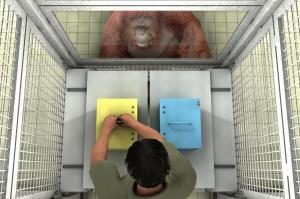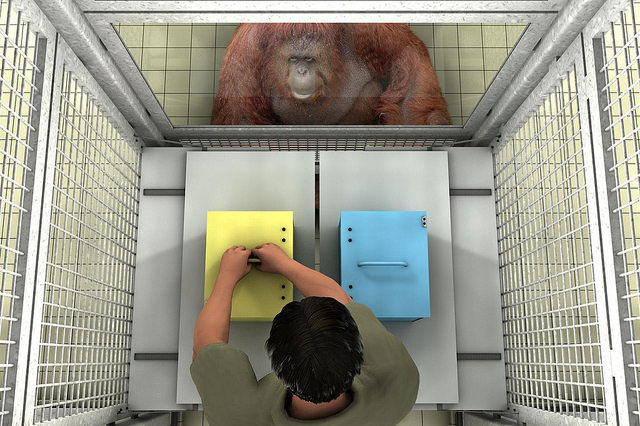
PLOS—Great apes help a person access an object when that person thinks they knows where it is but is mistaken, according to a study* published April 5, 2017 in the open-access journal PLOS ONE by David Buttelmann from Max Planck Institute for Evolutionary Anthropology, Germany, and colleagues.
Understanding when someone else has a false belief is a mark of advanced social cognition in people, and researchers had believed that great apes lacked this capacity. Using a test that was developed for 1.5-year-old human infants, Buttelmann and colleagues evaluated understanding of others’ beliefs in 34 great apes (chimpanzees, bonobos and orangutans) at the Leipzig Zoo in Germany.
The test involved a person placing an object in one of two boxes. Another person then took this object out of this box, put it into another box, and locked both boxes. For the true belief condition, the first person stayed in the room—so this person knew where the object was and thus had a true belief. For the false belief condition, however, the first person was out of the room during the switch—so while he thought he knew where the object was, he was mistaken and thus had a false belief. In both conditions, the first person tried to open the box he originally had put his object in. The apes knew how to unlock the boxes, and could decide which box to open for the first person during the test.
___________________________________
Right before the response phase, the experimenter tries to open the box which he believes contains his object (false-belief condition) or which he knows is empty (true-belief condition). In both conditions this is the same empty box; all that differs is the experimenter’s belief about what is in it. Credit: Buttelmann et al (2017)
_______________________________________________
The researchers found that, like human infants, great apes were more likely to help the person find the object when he had a false belief about which box the object was in. This suggests that great apes used their understanding of the person’s beliefs about reality to decide how to help him. If true, say the researchers, great apes, like people, may have the capacity to “read” the minds of others in social interactions.
“This study shows for the first time that great apes (chimpanzees, bonobos, and orangutans) can use an understanding of false beliefs to help others appropriately,” says David Buttelmann.
Article Source: PLOS One news release
_______________________________________________
*Buttelmann D, Buttelmann F, Carpenter M, Call J, Tomasello M (2017) Great apes distinguish true from false beliefs in an interactive helping task. PLoS ONE 12(4): e0173793. doi:10.1371/journal.pone.0173793
_______________________________________________
Open Call: A unique travel opportunity for educators, writers, students, and photographers. Read More





